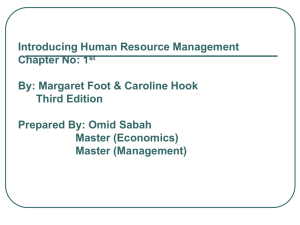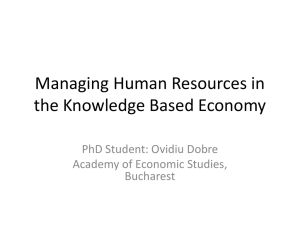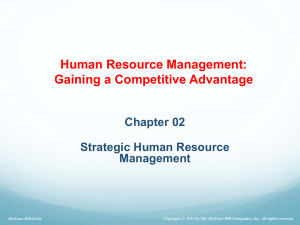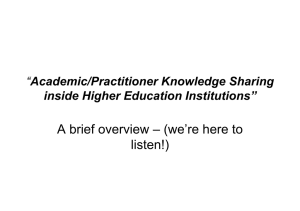HUMAN RESOURCE MANAGEMENT
advertisement
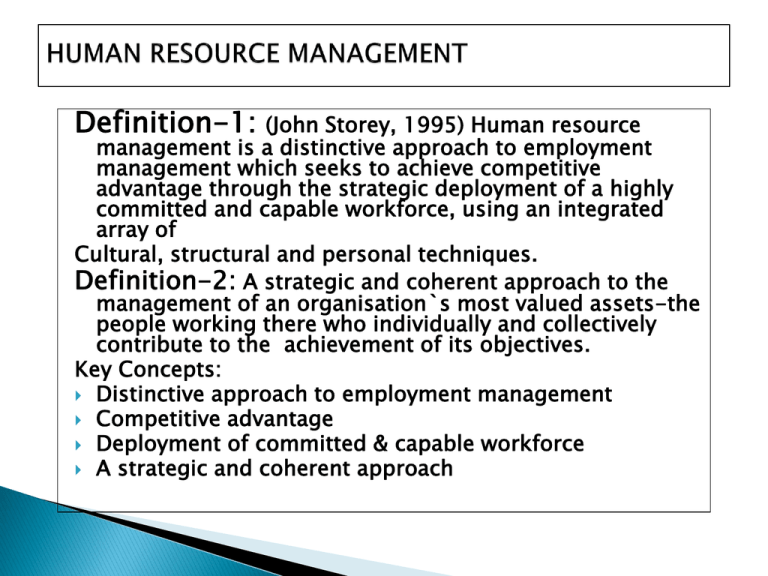
Definition-1: (John Storey, 1995) Human resource management is a distinctive approach to employment management which seeks to achieve competitive advantage through the strategic deployment of a highly committed and capable workforce, using an integrated array of Cultural, structural and personal techniques. Definition-2: A strategic and coherent approach to the management of an organisation`s most valued assets-the people working there who individually and collectively contribute to the achievement of its objectives. Key Concepts: Distinctive approach to employment management Competitive advantage Deployment of committed & capable workforce A strategic and coherent approach John Storey (1995), in New Perspectives on Human resource management, made a distinction between two versions of HRM. 1. HARD HRM: It emphasises the need to manage people in ways that will obtain added value from them and thus achieve competitive advantage. Thus it concentrates on quantitative, measurable criteria, control and performance management. The hard approach emphasises: The interests of management Adopting a strategic approach that is closely integrated with business strategy Obtaining added value from people by the process of human resource deployment and performance management The need for a strong corporate culture expressed in mission and value statements and reinforced by communications, training and performance management process. 2. SOFT VERSION:The soft model of HRM is based upon human relations school and is identified by Storey as involving `treating employees as valued assets, a source of competitive advantage through their commitment, adaptability and high quality. The need to gain commitment of employees The interests of management and employees should coincide Integration and team work HRM CONCEPTS US MODEL Matchin g Model THE UK MODEL THE JAPANESE MODEL HarvardDavid Guest John Storey Model ? 1. 2. THE MATCHING MODEL: the human resource system and organisation structure should match with organisational strategy. THE HARVARD MODEL: HRM is based on central philosophy and strategic vision HRM involves all management decisions and action that affect the nature of the relationship between the organisation and its employees. A longer term perspective in managing people and consideration of people as potential assets rather than variable costs. Mutual interests. MATCHING MODEL: The concept of FIT has been criticised on a number of fronts: A number of writers have commented that business strategy dictates HR strategy. Business strategy is formulated in a rational way, by the top down approach. A perfect match between business strategy and Hr strategy might not be to the advantage of the organisation as a whole. It ignores the complex nature of human beings and the possibility that workers and their unions might influence strategic planning. DAVID GUEST:has taken the Harvard Model and developed it further by defining 4 policy goals: Strategic Integration High Commitment High Quality Flexibility 2. John Storey; suggests four aspects which constitute the meaningful version of HRM HRM is constellation of beliefs & assumption The central involvement of line managers A strategic thrust informing decisions about people management Reliance upon a set of levers to shave the employment relationship 1. It is top management driven and management oriented activity It emphasises the need for strategic fit-the integration of business and HR strategies It is commitment oriented It can take either hard or soft form It is performance oriented Employee relations are unitarist rather than pluralist, individual rather than collective, high trust rather than low trust Reward according to performance, competence or skills. This model emanates from the Centre for Corporate Strategy and Change at the University of Warwick and with two particular researchers, Hendry and Pettigrew( 1990). The Warwick model draws heavily from the Harvard framework to extend the analysis of HRM and has five elements: 1) Outer context; 2) Inner context; 3) Business strategy content ; and 4) HRM content The model takes cognizance of HRM business strategy and HRM practices, the external and internal context in which these activities take place, and the process by which such change take place, including interactions between changes in both context and content. The strength of the model is that it identifies and classifies important environmental influences on HRM. Henry and Pettigrew’s research focused on mapping the context and exploring how HRM adapted to changes in Context. Out context: look at things like socioeconomic , technical ,political-legal competitive Inner context: culture, structure, politics/leadership , task-technology, business outputs Business strategy content:- objectives, product market strategy and tactics. The Storey model of HRM is derived from the speculative accounts of what the HRM paradigm( theory, concept ) might consists of. The model demonstrates the differences between what Storey termed the’ personnel and industrials’ and the HRM paradigm. His model also has four parts: Beliefs and assumptions Strategic aspects Line management and key levers The prevailing beliefs and assumptions of HRM, as pointed out by Guest ( 1987), are unitarist. HRM attempts to increase trust and employee commitment and aims to go ‘beyond the contract’. The strategic aspects of Storey’s model shows HRM central to corporate planning. The third component, line management, gives HRM specialists a’ transformational leadership’ role in the organisation. Evidence from ‘ core’ companies suggests that general managers and line managers have emerged in almost all cases as they key players on HR issues. The key levers are shown on the lower portion of Storey’s model and are issues and techniques strongly featured , explicitly or implicitly , in discussions of HRM. Storey found considerable unevenness in the adoption of these key levers( performance related pay, harmonisation of conditions and the learning The learning company). The model was used to advise a checklist of 25 key HRM variables to quantify the degree of movement from one approach to the other in fifteen ‘ core’ organisations( Storey , 1992). Explain the differences between Storey, Harvard, and Guest Models and discuss their similarities and importance to any organisation What role does human resource management play in organisations? To what extent is HRM different from conventional personnel management ?





